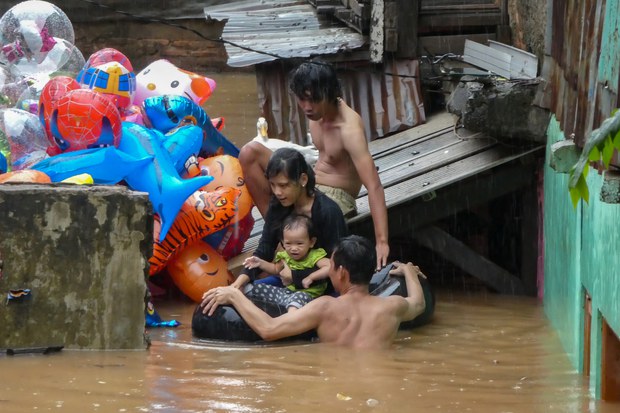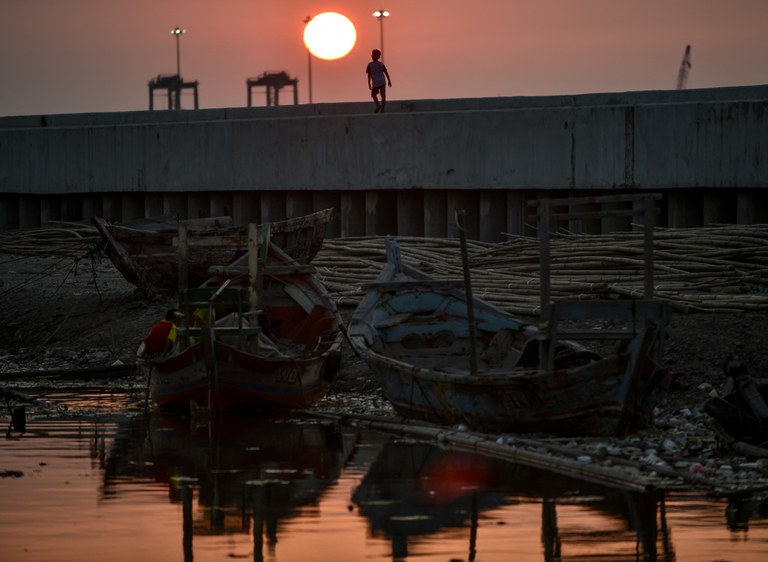Indonesia considers massive sea wall to save sinking Jakarta
2024.01.10
Jakarta
 A family leaves its home that’s overflowing with water after rain caused severe flooding in Jakarta, Jan. 1, 2020.
A family leaves its home that’s overflowing with water after rain caused severe flooding in Jakarta, Jan. 1, 2020.
Indonesia is considering building a massive sea wall along the northern coast of Java to save the island, particularly its largest city, Jakarta, from sinking and eventually being submerged, two ministers said Wednesday.
But critics warned that the U.S. $60 billion project would only aggravate the ecological and social crisis in the region, and urged the government to adopt a more environmentally friendly and socially just approach to the water-related problems.
Parts of Jakarta sink up to 25 cm annually because of excessive groundwater extraction and urban development, Airlangga Hartarto, the coordinating minister for the economy, said at a seminar on the project.
“We need the giant sea wall to stop the land from sinking and the sea from flooding, which keep happening all the time,” he said.
If it comes to fruition, the project would include the building of a 120-km (74.5-mile) coastal and river dike by 2030 and an adaptive sea wall to the west and east of Jakarta by 2040 before closing the sea wall with a reservoir by 2050, officials said.
The Jakarta city administration’s target is to finish the first phase of a program to build coastal embankments under the National Capital Integrated Coastal Development project by 2027.
So far, 13 km (10.6 miles) of the planned 46 km (28.5 miles) of the embankment have been constructed.

Airlangga estimated that the region loses 2.1 trillion rupiah (U.S. $135 million) per year, which could rise to 10 trillion rupiah ($642.7 million) per year in the next decade if no measures were taken and the flooding worsens.
Java is Indonesia’s most populous and economically important island. Land subsidence, or sinking, is a serious problem in Java’s coastal areas, especially Jakarta and Semarang in Central Java province, making them more vulnerable to tidal floods, salt water intrusion and water shortages.
The government said the decline in groundwater levels in the northern coast of Java is 1 to 25 cm per year, while the rise in sea levels is 1 to 15 cm per year, which causes tidal floods of around 5 to 200 cm.
The sea wall project also aims to address the water supply problem in Jakarta, which relies on groundwater extraction. The wall would include within it a freshwater reservoir to store rainwater and river water and provide clean water for the city.
Defense Minister Prabowo Subianto said the project’s hefty cost of between $50 billion (778 trillion rupiah) and $60 billion (933 trillion rupiah) was a necessary expense to address geological concerns on Java’s north coast.
“The Netherlands did the same thing, and it took them 40 years. The challenge is to have political leaders who can think ahead and use all their resources for 40 to 50 years,” Prabowo said at the seminar.
‘How to stop subsidence’
Elisa Sutanudjaja, the executive director of Rujak Center for Urban Studies, said government officials aren’t doing anything to prevent groundwater extraction.
“[T]hey don’t talk at all about how to stop subsidence,” Elisa told BenarNews.
She also questioned Prabowo’s presence at the seminar. “It is as if there was a hidden agenda,” Elisa said, without elaborating.
Prabowo is one of three candidates in the country’s Feb. 14 presidential election.
While the government is considering the sea wall project, it is also moving ahead with another ambitious plan – relocating the national capital from Jakarta to a site within the jungle of East Kalimantan on Borneo island.
President Joko “Jokowi” Widodo proposed a plan in 2019 to build a new capital 1,300 km (800 miles) from Jakarta, citing the city’s chronic flooding and traffic problems as the reason. Construction of the new city, called Nusantara, has begun.
Government officials said Nusantara will be a “sustainable forest city” that puts the environment at the heart of the development and aims to be carbon-neutral by 2045.

Some experts on Wednesday suggested more environmentally friendly alternatives to reduce tidal floods.
The idea of building a gigantic sea wall in Jakarta was first proposed in 2010, but it faced opposition from some environmental groups and local politicians, who argued that it would disrupt many livelihoods and damage the marine ecosystem.
A coalition of environmental and social groups called Maleh Dadi Segoro said that instead of solving the problems of land sinking and coastal floods, the sea wall project would create more difficulties for the region’s residents and the environment.
It could narrow and close the fishing catch area, threatening the livelihoods of many who depend on the sea for their food and income, the coalition said.
“The sea wall will destroy the natural habitats and biodiversity of the coast, which provide ecological services and protection for the people and the environment,” Maleh Dadi Segoro said.
Nirwono Joga, a city planning observer from Trisakti University, said the main cause of land subsidence in the north coast was uncontrolled groundwater extraction caused by a limited supply of clean water and high demand for buildings and industry.
Additionally, heavy vehicles and logistics trucks add to the pressure and compaction of the north coast’s alluvial soil, he told BenarNews.
“Why not choose or combine a more environmentally friendly approach, such as restoration of the Jakarta coastal area and mangrove reforestation as a natural barrier to reduce tidal floods, tsunamis and the threat of drowning, which is cheaper and easier?” he said.
“The construction of the giant sea wall must be reviewed with regard to its funding and efficacy.”







